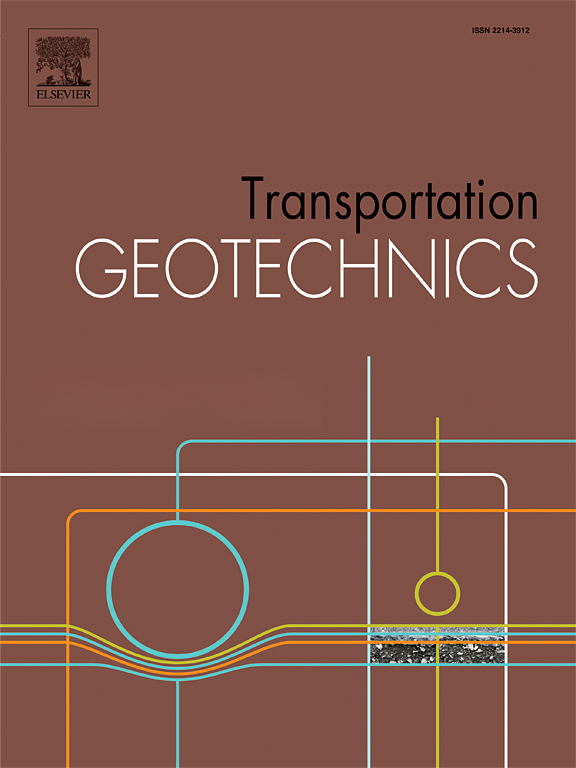加载-卸载路径下不同颗粒形状非饱和砂土的水力学行为:数值模拟与试验验证
IF 4.9
2区 工程技术
Q1 ENGINEERING, CIVIL
引用次数: 0
摘要
研究了颗粒形状和初始吸力对非饱和砂土流体力学行为的同时影响。采用直剪装置对三种不同形状的砂(Firoozkooh最角、Babolsar次角和Mesr最圆)进行了等含水量条件下的各向异性加载-卸载试验。使用扫描电子显微镜(SEM)测试的结果,颗粒形状在球形、圆度和规律性方面进行了量化。建立了基于弹粘塑性的流体力学耦合模型,并与实验结果进行了对比验证。然后利用该模型进行参数化研究(压缩性、孔隙水压力和渗透率),重点研究颗粒形态和形状的作用。结果表明:与角砂相比,较圆的颗粒(规整性较高)在较低吸力下的体积应变(εv)较大,但随着吸力的增大,εv减小。近饱和条件下,Mesr砂加载时渗透率降低速率分别是Babolsar砂和Firoozkooh砂的1.5倍和2.4倍。然而,随着吸力的增加,这个量减小。孔隙水压力(PWP)的产生在最棱角砂中是最高的,这是由于其截留特性。孔隙率与PWP之间的关系与加载周期无关,呈线性相关。颗粒形状对这一关系有显著影响,更圆的砂在PWP中每单位变化的孔隙比变化率更高。本文章由计算机程序翻译,如有差异,请以英文原文为准。
Hydromechanical behavior of unsaturated sandy soils with different particle shapes under loading–unloading paths: Numerical simulation and experimental validation
This study investigates the simultaneous influence of particle shape and initial suction on the hydromechanical behavior of unsaturated sandy soils. Anisotropic loading–unloading tests at constant water content conditions were conducted on three sands with distinct shapes (Firoozkooh – most angular, Babolsar – Subangular, and Mesr – roundest) using a direct shear apparatus. Particle shapes were quantified in terms of sphericity, roundness, and regularity using the results of scanning electron microscopy (SEM) tests. In addition, a coupled hydromechanical model based on elasto-viscoplasticity was developed and validated against the experimental results first. The model was then employed to conduct a parametric study (compressibility, pore water pressure, and permeability) with an emphasis on the role of particle morphology and shape. The findings revealed rounder particles (higher regularity) experienced higher volumetric strain () under lower suction but less with increasing suction compared to angular sands. Moreover, the rate of permeability reduction during loading in Mesr sand was 1.5 times and 2.4 times higher than that of Babolsar and Firoozkooh sands at near-saturation condition. However, this amount decreased with increasing suction. Pore water pressure (PWP) generation was highest in the most angular sand due to its retention characteristics. The relationship between void ratio and PWP was independent of loading cycles and exhibited a linear dependence. Particle shape significantly impacted this relationship, with rounder sands showing a higher rate of void ratio change per unit change in PWP.
求助全文
通过发布文献求助,成功后即可免费获取论文全文。
去求助
来源期刊

Transportation Geotechnics
Social Sciences-Transportation
CiteScore
8.10
自引率
11.30%
发文量
194
审稿时长
51 days
期刊介绍:
Transportation Geotechnics is a journal dedicated to publishing high-quality, theoretical, and applied papers that cover all facets of geotechnics for transportation infrastructure such as roads, highways, railways, underground railways, airfields, and waterways. The journal places a special emphasis on case studies that present original work relevant to the sustainable construction of transportation infrastructure. The scope of topics it addresses includes the geotechnical properties of geomaterials for sustainable and rational design and construction, the behavior of compacted and stabilized geomaterials, the use of geosynthetics and reinforcement in constructed layers and interlayers, ground improvement and slope stability for transportation infrastructures, compaction technology and management, maintenance technology, the impact of climate, embankments for highways and high-speed trains, transition zones, dredging, underwater geotechnics for infrastructure purposes, and the modeling of multi-layered structures and supporting ground under dynamic and repeated loads.
 求助内容:
求助内容: 应助结果提醒方式:
应助结果提醒方式:


